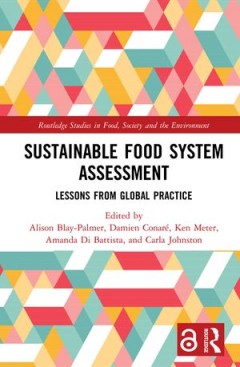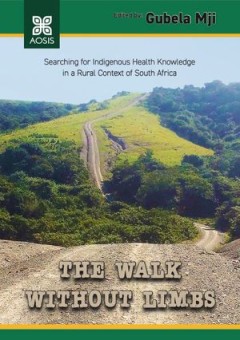Filter by

Atlas of Butterflies and Diurnal Moths in the Monsoon Tropics of Northern Aus…
Northern Australia is one of few tropical places left on Earth in which biodiversity—and the ecological processes underpinning that biodiversity—is still relatively intact. However, scientific knowledge of that biodiversity is still in its infancy and the region remains a frontier for biological discovery. The butterfly and diurnal moth assemblages of the area, and their intimate associatio…
- Edition
- -
- ISBN/ISSN
- 9781760462321
- Collation
- -
- Series Title
- -
- Call Number
- -

Sustainable Food System Assessment Lessons from Global Practice
Sustainable Food System Assessment provides both practical and theoretical insights about the growing interest in and response to measuring food system sustainability. Bringing together research from the Global North and South, this book shares lessons learned, explores intended and actual project outcomes, and highlights points of conceptual and methodological convergence.Interest in assessing…
- Edition
- -
- ISBN/ISSN
- 0429801394, 9780429801396
- Collation
- -
- Series Title
- -
- Call Number
- -

Society, Environment and Human Security in the Arctic Barents Region
The Arctic-Barents Region is facing numerous pressures from a variety of sources, including the effect of environmental changes and extractive industrial developments. The threats arising out of these pressures result in human security challenges.This book analyses the formation, and promotion, of societal security within the context of the Arctic-Barents Region. It applies the human security f…
- Edition
- -
- ISBN/ISSN
- 9781351171236, 1351171232
- Collation
- -
- Series Title
- -
- Call Number
- -

Public Participation, Science and Society Tools for Dynamic and Responsible …
The field of public participation is developing fast, with phenomena such as citizen science and crowdsourcing extending the resource base of research, stimulating innovation and making science more accessible to the general population.Promoting public participation means giving more weight to citizens and civil society actors in the definition of research needs and in the implementation of res…
- Edition
- -
- ISBN/ISSN
- 9781351272957, 1351272950
- Collation
- -
- Series Title
- -
- Call Number
- -

The Politics of Uncertainty Challenges of Transformation
Why is uncertainty so important to politics today? To explore the underlying reasons, issues and challenges, this book’s chapters address finance and banking, insurance, technology regulation and critical infrastructures, as well as climate change, infectious disease responses, natural disasters, migration, crime and security and spirituality and religion.The book argues that uncertainties mu…
- Edition
- -
- ISBN/ISSN
- 9781000163445, 100016344X
- Collation
- -
- Series Title
- -
- Call Number
- -

The Circular Economy in Europe Critical Perspectives on Policies and Imagina…
The Circular Economy in Europe presents an overview and a critical discussion on how circularity is conceived, imagined, and enacted in current EU policy-making. In 2013, the idea of a circular economy entered the stage of European policy-making in the efforts to reconcile environmental and economic policy objectives. In 2019 the European Commission declared in a press release that the Circular…
- Edition
- -
- ISBN/ISSN
- 9780429578724, 0429578725
- Collation
- -
- Series Title
- -
- Call Number
- -

Sustainable Living with Environmental Risks
We are not free from environmental risks that accompany the development of human societies. Modern economic development has accelerated environmental pollution, caused loss of natural habitats, and modified landscapes. These environmental changes have impacted natural systems: water and heat circulation, nutrient cycling, and biodiversity. These changes in natural systems degrade ecosystem serv…
- Edition
- -
- ISBN/ISSN
- 9784431548041
- Collation
- -
- Series Title
- -
- Call Number
- -

The walk without limbs: Searching for indigenous health knowledge in a rural …
In a country as diverse as South Africa, sickness and health often mean different things to different people – so much so that the different health definitions and health belief models in the country seem to have a profound influence on the health-seeking behaviour of the people who are part of our vibrant, multicultural society. This book is concerned with the integration of indigenous healt…
- Edition
- -
- ISBN/ISSN
- 9781928523123
- Collation
- -
- Series Title
- -
- Call Number
- -

Medicinal Effects of Agathosma (Buchu) Extracts
The research results presented in this book span the quest of Cape Kingdom Nutraceuticals, Prof. Patrick Bouic and Prof. Barbara Huisamen to scientifically validate the health promoting properties of an aqueous extract of the plant Agathosma. To accomplish this, they made use of both in vitro and in vivo models to understand and underscore the anecdotal information of the benefits of this produ…
- Edition
- -
- ISBN/ISSN
- 9781928396826
- Collation
- -
- Series Title
- -
- Call Number
- -

Sustainable Development Goal 3: Health and Well-being of Ageing in Hong Kong
Sustainable Development Goals (SDGs) aim to develop a better and sustainable future for the world and the goals are part of an action plan to address poverty, hunger, health, gender equity and various pressing world issues. One of these goals looks at health and wellness. Ageing populations have become a crucial issue worldwide and this short monograph explores ageing and how the consequences o…
- Edition
- -
- ISBN/ISSN
- 9781000544282, 1000544281
- Collation
- -
- Series Title
- -
- Call Number
- -
 Computer Science, Information & General Works
Computer Science, Information & General Works  Philosophy & Psychology
Philosophy & Psychology  Religion
Religion  Social Sciences
Social Sciences  Language
Language  Pure Science
Pure Science  Applied Sciences
Applied Sciences  Art & Recreation
Art & Recreation  Literature
Literature  History & Geography
History & Geography